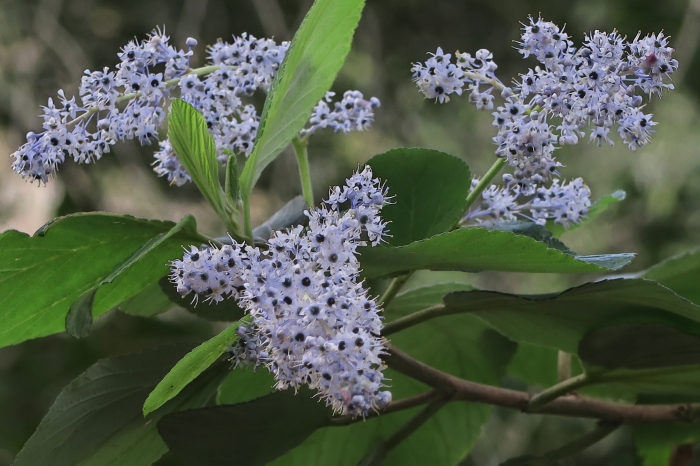Feltleaf Ceanothus
(Ceanothus arboreus)
Feltleaf Ceanothus (Ceanothus arboreus)
/
/

John Rusk
CC BY 2.0
Image By:
John Rusk
Recorded By:
Copyright:
CC BY 2.0
Copyright Notice:
Photo by: John Rusk | License Type: CC BY 2.0 | License URL: https://creativecommons.org/licenses/by/2.0 | Uploader: Josve05a | Publisher: Wikipedia Commons |















Estimated Native Range
Summary
Ceanothus arboreus, commonly known as Feltleaf Ceanothus or Island Mountain Lilac, is a perennial shrub to small tree. As the largest member of the Ceanothus genus, it can grow up to 12–36 feet (3.7–11.0 m) in height and is native to the chaparral and coastal sage scrub habitats on the Channel Islands of California and Guadalupe Island in Mexico. This species was only rediscovered on Guadalupe Island after the elimination of feral goats, which had significantly altered the island’s ecology. Feltleaf Ceanothus has a spreading habit with glossy, dark green foliage that is leathery or felt-like on the undersides. Its showy bright blue flowers, which can range from pale to dark blue, bloom in plentiful panicles from February to April, attracting butterflies and providing food for quail that consume the seeds. The fruits are distinctive three-lobed, triangular capsules.
Feltleaf Ceanothus is valued for its drought tolerance and wildlife-friendly attributes, making it suitable for use in xeriscaping, natural landscaping, and as a focal point in gardens. It thrives in full sun and can adapt to low or medium water conditions, preferring soils with slow or medium drainage. While it is a low-maintenance plant, it can suffer from root rot if overwatered or planted in poorly drained soils. It is also susceptible to pests like aphids and scale insects. Gardeners should be aware that Ceanothus species can be short-lived and may need replacement after several years. Despite this, their ecological benefits and ornamental qualities make them a popular choice for sustainable gardening practices.CC BY-SA 4.0
Feltleaf Ceanothus is valued for its drought tolerance and wildlife-friendly attributes, making it suitable for use in xeriscaping, natural landscaping, and as a focal point in gardens. It thrives in full sun and can adapt to low or medium water conditions, preferring soils with slow or medium drainage. While it is a low-maintenance plant, it can suffer from root rot if overwatered or planted in poorly drained soils. It is also susceptible to pests like aphids and scale insects. Gardeners should be aware that Ceanothus species can be short-lived and may need replacement after several years. Despite this, their ecological benefits and ornamental qualities make them a popular choice for sustainable gardening practices.CC BY-SA 4.0
Plant Description
- Plant Type: Tree, Shrub
- Height: 15-25 feet
- Width: 6-12 feet
- Growth Rate: Moderate
- Flower Color: Blue, Purple, White
- Flowering Season: Spring
- Leaf Retention: Evergreen
Growth Requirements
- Sun: Full Sun, Part Shade
- Water: Low, Medium
- Drainage: Slow, Medium
Common Uses
Bee Garden, Bird Garden, Border Plant, Butterfly Garden, Drought Tolerant, Fragrant, Hedges, Hummingbird Garden, Low Maintenance, Salt Tolerant, Showy Flowers, Street Planting
Natural Habitat
Native to chaparral and coastal sage scrub habitats on the Channel Islands of California and Guadalupe Island in Mexico
Other Names
Common Names: Catalina Mountain-Lilac, Felt-Leaf Ceanothus, Island Ceanothus, Island Mountain Lilac
Scientific Names: , Ceanothus arboreus, Ceanothus arboreus var. glaber, Ceanothus arboreus var. glabra, Ceanothus velutinus var. arboreus,
GBIF Accepted Name: Ceanothus arboreus Greene